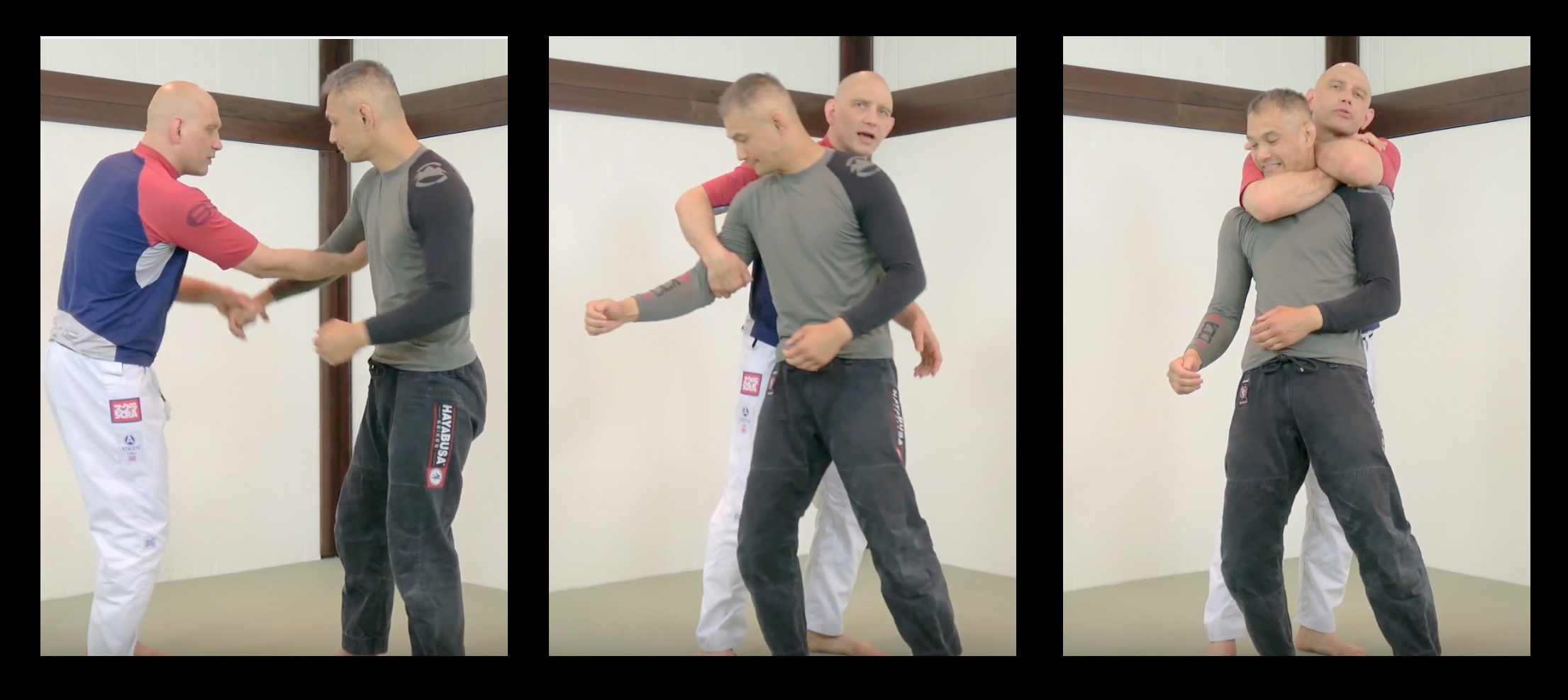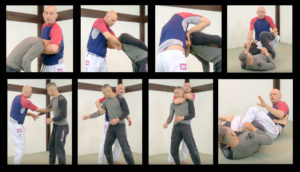In self defense you need at least some submissions in your arsenal. Breaking someone’s arm or putting them to sleep with a choke is often a much more effective (and safer) strategy than standing in front of the guy and trading haymakers.
Now when it comes to submissions you have thousands of options: armlocks, chokes, wrist locks, neck cranks, face crushes etc.
But training time is always limited, so you have to focus. Prioritise your training efforts on the techniques that’ll give you the maximum benefit in the minimum time.
In the video below I take you through the 3 most important submissions for self defense.
Then in the section below we’ll go into some more detail and give you a few more resources that should help you with your efforts.
First, watch this 5:42 long video…
In the video above I talked about the 3 most important submissions for self defense, which are the guillotine choke, the rear naked choke, and the heel hook.
Let’s look at each of those submissions in more detail…
1, The Guillotine Submission
The most common use of the guillotine choke from a self defense perspective is to punish someone who is rushing for forward and trying to tackle you. But it can also be used to finish someone after you’ve slumped them forward with a groin kick, knee to the body, or snapped them down from the clinch.
I sometimes get asked about the danger of someone pulling a weapon out while you’ve committed both hands to the choke around his neck…
While this is theoretically possible (and you should definitely keep monitoring both of his hands as best as you can) a properly executed guillotine submission isn’t a long, languid submission. Instead it comes on so quickly, and breaks someone’s posture so completely, that likely the only thing they’re going to be thinking about is their neck and not fumbling around to get access to a knife or other weapon.
Similarly some people are worried about the standing guillotine because the groin is theoretically exposed. Once again there is no 100% safe technique, but the reality is that if you bend the guy’s neck until it looks like a question mark then he probably won’t even be able to find your groin with his fists, let alone generate any power behind his shots at all.
The next thing to know about the guillotine choke is that there isn’t just one guillotine choke; there are at least a dozen major variations (the standard guillotine, 10 finger guillotine, Codytine, arm-in guillotine, front RNC guillotine, etc.).
My current favourite is called the ‘Marcelotine’ and I cover it at the 27 second mark of this video here on Youtube. It comes on incredibly fast and doesn’t require a ton of upper body strength. And it’s so powerful that even if your opponent manages to thrash his way free he’ll have the fear of God put into him and likely won’t want to try closing the distance with you again.
Ultimately it doesn’t matter which variation you learn so long as it fits your body type. How do you know if it fits your body type? When you can use it with some regularity in sparring to tap out a resisting opponent!
So go ahead and add a guillotine – any guillotine – to your street submission arsenal!
2, The Rear Naked Choke Submission

The Rear Naked Choke (also known as the RNC, Lion Killer, Sleeper Hold or Hadaka Jime) submission is one of the most iconic jiu-jitsu self defense techniques.
Properly applied at full power you should be able to render an opponent completely unconscious in less than 10 seconds while staying behind him in a position where it’s actually very difficult for him to hurt you.
You can apply this choke almost any time you’re behind someone, both standing and on the ground.
There are lots of resources out there to help you put a razor’s edge onto this technique…
First, here’s how to apply the Rear Naked Choke step-by-step. It’s an old video but don’t let that fool you – I still use most of these exact same steps to choke someone out every time I end up on the back!
Now here’s a video showing you a bunch of options if your opponent does the natural thing and tries to block the choke by keeping his chin down. As he’ll quickly find out, the jaw is no defense against the power of the RNC submission.
3, The Heel Hook Submission

When I was in the Canadian Arctic I talked to some Inuit hunters about how they took down polar bears.
Polar bears are huge, dangerous animals that can run as fast as a horse. They’re also incredibly tough, so if you don’t drop it with your first shot then there’s a very real possibility of it charging you with the intention of ripping you into small bloody pieces.
So the first thing these hunters would do is shoot the polar bear in the rear hip, because now they could run faster than the bear.
Once the bear was disabled they could finish it off at their leisure.
In a similar way the heel hook is the fastest way to remove someone’s ability to run after you. Or even to walk at all.
Break his leg and then stroll away at your leisure.
This is also the single best joint lock for taking out a much larger opponent. Correctly done it attacks the ligaments of the foot, knee and ankle, and those relatively small ligaments tear easily if you apply the strength of your whole body against them (even if the guy is 100 lbs heavier than you).
Another thing to consider is that if you’re applying the heel hook correctly then it is almost impossible for him to stand up and hit you effectively. That’s because before you apply the lock you first entangle his legs with your own, allowing you to control the position and limit his ability to move.
(The only caveat for going to the heel hook is that you have to be fairly sure he isn’t armed since you don’t have control over his arms. Every technique has its limitations, and understanding what those limitations are allows you to pick and choose the right move for the situation you’re in.)
Just like all the most combat effective techniques, the heel hook can be trained at progressively greater levels of resistance BUT YOU NEED TO BE CAREFUL!!
So before you go and add this technique to your self defense submission arsenal sit down and watch this video below.
If you enjoyed this article and found it useful then consider signing up for the Self Defense Tutorials email newsletter.
Not only will we send you our best material by email, but you’ll also get instant access to our self defense PDF library.

